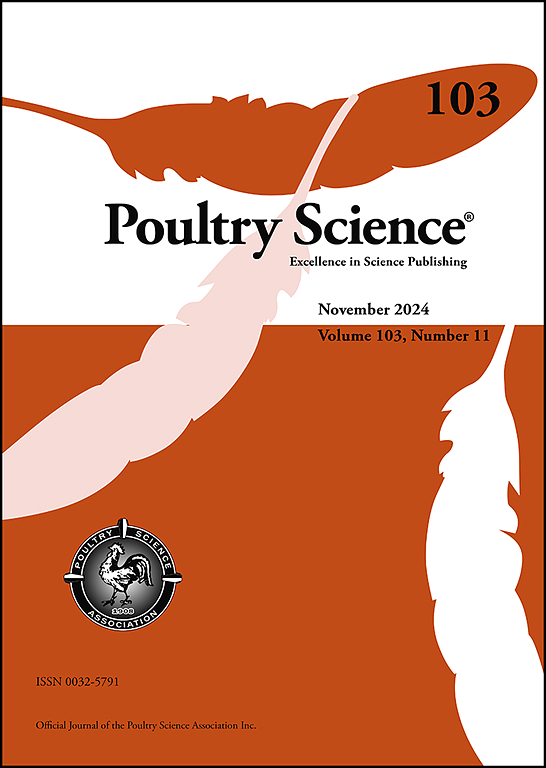Identify key transcript factors of adipocyte differentiation in abdominal fat of broilers based on ATAC-seq and RNA-seq
IF 3.8
1区 农林科学
Q1 AGRICULTURE, DAIRY & ANIMAL SCIENCE
引用次数: 0
Abstract
Intensive breeding has resulted in excessive deposition of abdominal fat tissue (AFT) in broilers, leading to significant economic loss in the poultry industry. Understanding the molecular mechanisms underlying AFT development is essential for informed breeding strategies. In the current study, we elucidated dynamic changes of chromatin accessibility and transcriptional reprogramming in AFT at D14 and D42 in broilers based on integrated analysis of RNA-seq and ATAC-seq. RNA-seq analysis manifested significant transcriptional differences in AFT development, identifying 1323 up- and 1285 down-regulated differential expression genes (DEGs) as well as 63 up- and 58 down-regulated transcription factors (TFs) at D42 compared to those at D14. Kyoto Encyclopedia of Genes and Genomes (KEGG) analysis of total DEGs revealed significant enrichment in pathways related to DNA replication, cell adhesion molecules, cell cycle, p53 signaling pathway, fatty acid degradation, fatty acid biosynthesis and steroid biosynthesis. Gene set enrichment analysis (GSEA) further indicated that autophagy, MAPK signaling pathway and inositol phosphate metabolism were up-regulated at D42 compared to D14, whereas cell cycle, DNA replication and steroid biosynthesis were down-regulated. Additionally, ATAC-seq analysis identified 394 gain and 1195 loss differentially accessible peaks (DPs) in AFT between D14 and D42, associated with 319 and 905 genes, respectively. These gain or loss genes were enriched in p53 signaling pathway, PPAR signaling pathway, fat digestion and absorption, FoxO signaling pathway and glycerol lipid metabolism. Integration analysis of ATAC-seq and RNA-seq data revealed 25 up-regulated and 75 down-regulated DEGs overlapping with genes linked to gain and loss DPs, respectively. Notably, ACACA, SCD, SREBF1and KLF9 exhibited significantly lower expression at D42 compared to D14. DNA motifs analysis identified NFIX and MYB as loss motifs, overlapping with down-regulated TFs, suggesting their potential role in AFT regulation. Furthermore, MYB and NFIX exhibited potential binding sites in the promoter regions of lipid metabolism-related genes (ELOVL6, PPARγ, FABP4, ACACA and SCD). Overall, these results will provide a theoretical basis for investigating the epigenetic modification and transcriptional regulation of AFT development in broilers.
求助全文
约1分钟内获得全文
求助全文
来源期刊

Poultry Science
农林科学-奶制品与动物科学
CiteScore
7.60
自引率
15.90%
发文量
0
审稿时长
94 days
期刊介绍:
First self-published in 1921, Poultry Science is an internationally renowned monthly journal, known as the authoritative source for a broad range of poultry information and high-caliber research. The journal plays a pivotal role in the dissemination of preeminent poultry-related knowledge across all disciplines. As of January 2020, Poultry Science will become an Open Access journal with no subscription charges, meaning authors who publish here can make their research immediately, permanently, and freely accessible worldwide while retaining copyright to their work. Papers submitted for publication after October 1, 2019 will be published as Open Access papers.
An international journal, Poultry Science publishes original papers, research notes, symposium papers, and reviews of basic science as applied to poultry. This authoritative source of poultry information is consistently ranked by ISI Impact Factor as one of the top 10 agriculture, dairy and animal science journals to deliver high-caliber research. Currently it is the highest-ranked (by Impact Factor and Eigenfactor) journal dedicated to publishing poultry research. Subject areas include breeding, genetics, education, production, management, environment, health, behavior, welfare, immunology, molecular biology, metabolism, nutrition, physiology, reproduction, processing, and products.
 求助内容:
求助内容: 应助结果提醒方式:
应助结果提醒方式:


